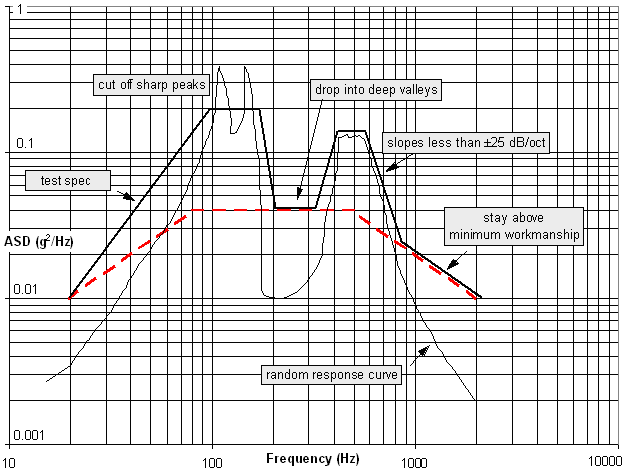


Creating a Random Vibration Component Test Specification
One purpose for performing a random vibration analysis is to create a component test level specification. With a finite element model, a random vibration analysis can be performed to predict acceleration responses from 20 Hz to 2000 Hz. This response is in turn used as a template to derive a test level specification. Use these guidelines to create the spec.
- From NASTRAN random vibration response data (or whatever analysis software you're using), create a log-log plot of the response of ASD (acceleration spectral density) vs. frequency.
NOTE This will work using any type of ASD response curve. For example, if an engineering model (EM) is being tested, responses from accelerometers on the EM can also be used. - Add in Component Minimum Workmanship to the plot. For components less than 100 lbs (45.4 kg), NASA uses these values from GEVS, Table 2.4-5:
Minimum Workmanship Frequency ASD 20 Hz 0.01 g2/Hz 20-80 Hz +3 dB/oct. 80-500 Hz 0.04 g2/Hz 500-2000 Hz -3 dB/oct. 2000 Hz 0.01 g2/Hz Overall 6.8 grms
- Enclose response curve inside test spec curve using the following rules:
- Slopes should be less than + 25 dB/oct or greater than - 25 dB/oct
(this depends on your shaker table, consult your test engineer for exact slope limits); - Frequency bands should be greater than 10 Hz;
- Donít plot spec below Minimum Workmanship;
- Sharp peaks can be cut off at about 1/2 their height (-3 dB)*
e.g., a sharp peak of 0.52 g2/Hz can be cut off at > 0.26 g2/Hz; - Drop spec curve into valleys that are large;
- Try to keep the overall grms level of the spec to be no more than 1.25 times the overall grms level of the response curve.
- Slopes should be less than + 25 dB/oct or greater than - 25 dB/oct
The following plot is an example of a spec to be used for component random vibration testing.

* NOTE: 3dB (3.01dB to be exact) is a factor of 2 for ASD curves (g2/Hz) while 6dB is a factor of 2 for grms values. For example, reducing a peak ASD value of 12g2/Hz -3dB would give you 6g2/Hz; reducing a value of 12grms -3dB results in a value of 8.48grms and reducing it -6dB results in a value of 6.0grms. This tends to be confusing for people new to random vibration.
Thanks to Bob Coladonato, retired from Goddard, for his assistance with this page.
Ryan Simmons
August 1997